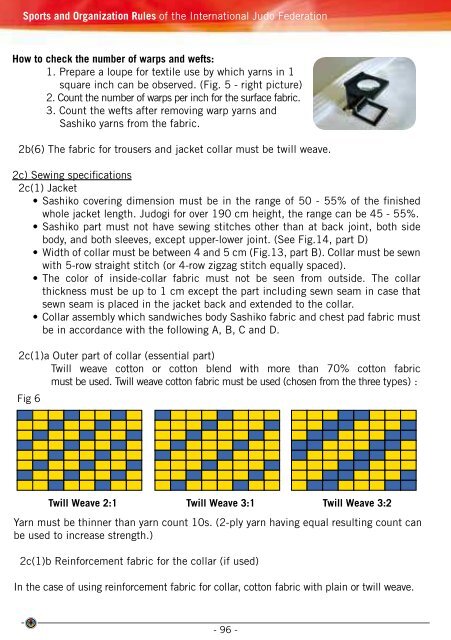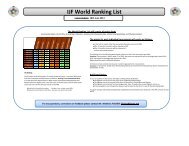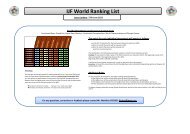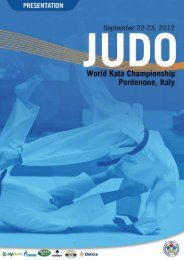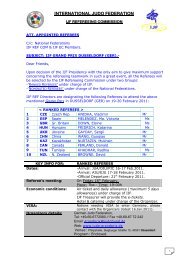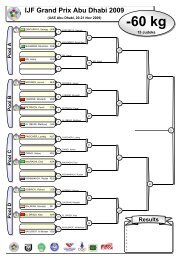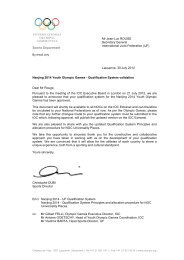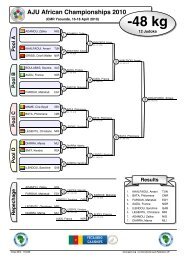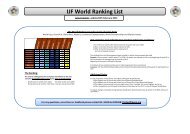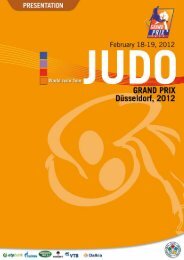Sports and Organization Rules of the International Judo Federation ...
Sports and Organization Rules of the International Judo Federation ...
Sports and Organization Rules of the International Judo Federation ...
You also want an ePaper? Increase the reach of your titles
YUMPU automatically turns print PDFs into web optimized ePapers that Google loves.
<strong>Sports</strong> <strong>and</strong> <strong>Organization</strong> <strong>Rules</strong> <strong>of</strong> <strong>the</strong> <strong>International</strong> <strong>Judo</strong> <strong>Federation</strong><br />
Twill Weave 2:1 Twill Weave 3:1 Twill Weave 3:2<br />
How to check <strong>the</strong> number <strong>of</strong> warps <strong>and</strong> wefts:<br />
1. Prepare a loupe for textile use by which yarns in 1<br />
square inch can be observed. (Fig. 5 - right picture)<br />
2. Count <strong>the</strong> number <strong>of</strong> warps per inch for <strong>the</strong> surface fabric.<br />
3. Count <strong>the</strong> wefts after removing warp yarns <strong>and</strong><br />
Sashiko yarns from <strong>the</strong> fabric.<br />
Fig 7<br />
2b(6) The fabric for trousers <strong>and</strong> jacket collar must be twill weave.<br />
2c) Sewing specifications<br />
2c(1) Jacket<br />
• Sashiko covering dimension must be in <strong>the</strong> range <strong>of</strong> 50 - 55% <strong>of</strong> <strong>the</strong> finished<br />
whole jacket length. <strong>Judo</strong>gi for over 190 cm height, <strong>the</strong> range can be 45 - 55%.<br />
• Sashiko part must not have sewing stitches o<strong>the</strong>r than at back joint, both side<br />
body, <strong>and</strong> both sleeves, except upper-lower joint. (See Fig.14, part D)<br />
• Width <strong>of</strong> collar must be between 4 <strong>and</strong> 5 cm (Fig.13, part B). Collar must be sewn<br />
with 5-row straight stitch (or 4-row zigzag stitch equally spaced).<br />
• The color <strong>of</strong> inside-collar fabric must not be seen from outside. The collar<br />
thickness must be up to 1 cm except <strong>the</strong> part including sewn seam in case that<br />
sewn seam is placed in <strong>the</strong> jacket back <strong>and</strong> extended to <strong>the</strong> collar.<br />
• Collar assembly which s<strong>and</strong>wiches body Sashiko fabric <strong>and</strong> chest pad fabric must<br />
be in accordance with <strong>the</strong> following A, B, C <strong>and</strong> D.<br />
2c(1)a Outer part <strong>of</strong> collar (essential part)<br />
Twill weave cotton or cotton blend with more than 70% cotton fabric<br />
must be used. Twill weave cotton fabric must be used (chosen from <strong>the</strong> three types) :<br />
Fig 6<br />
Twill Weave 2:1 Twill Weave 3:1 Plain Weave 1:1<br />
Yarn must be thinner than yarn count 10s.<br />
2c(1)c Main core material (essential part)<br />
Main core material for collar must be one <strong>of</strong> <strong>the</strong> 4 materials, throstle spun<br />
yarn fabric (Garabo), non-woven fabric, felt, or diamond -patterned fabric.<br />
2c(1)d Sub core material (if used)<br />
In <strong>the</strong> case <strong>of</strong> using sub core material, use a material as specified in above C.<br />
Note: The purpose <strong>of</strong> specification above is to prevent collar from becoming too hard to grip<br />
by setting <strong>the</strong> upper limit on <strong>the</strong> collar thickness.<br />
How to check <strong>the</strong> hardness <strong>of</strong> <strong>the</strong> collar<br />
(after washed <strong>and</strong> dried)<br />
Fold <strong>the</strong> collar, at <strong>the</strong> chest pad inserted<br />
part, into two <strong>and</strong> place 10 kg-weight on<br />
5cm point from <strong>the</strong> folding axis.<br />
Fig. 8: Cross-section <strong>of</strong> Collar (Example)<br />
Twill Weave 2:1<br />
Twill Weave 3:1 Twill Weave 3:2<br />
Yarn must be thinner than yarn count 10s. (2-ply yarn having equal resulting count can<br />
be used to increase strength.)<br />
Fig 7<br />
2c(1)b Reinforcement fabric for <strong>the</strong> collar (if used)<br />
Note: At this time, do not touch around <strong>the</strong><br />
folding axis to avoid any pressing force.<br />
In <strong>the</strong> case <strong>of</strong> using reinforcement fabric for collar, cotton fabric with plain or twill weave.<br />
- 96 -<br />
- 97 -


